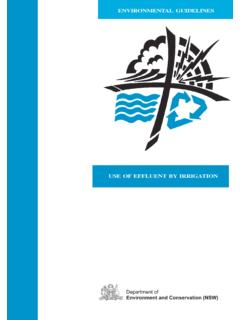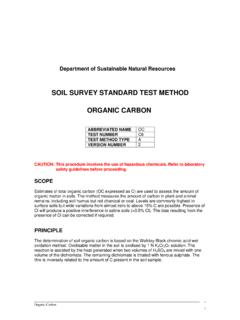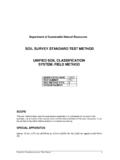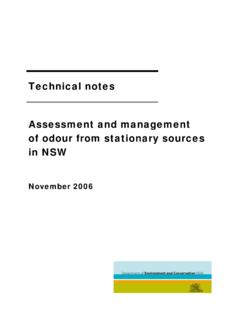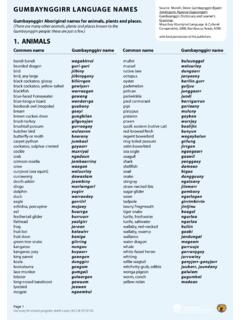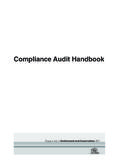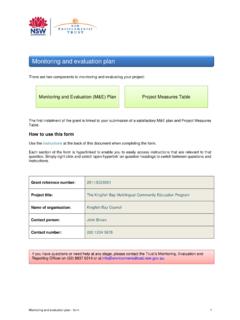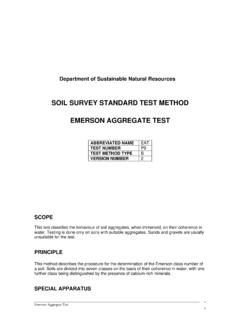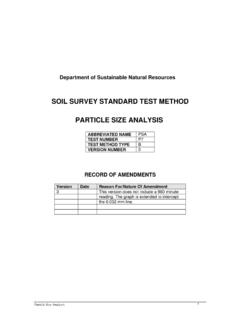Transcription of Guidelines for Erosion & Sediment Control on Building Sites
1 Guidelines for Erosion & Sediment Control on Building Sites A partnership project led by the Department of Land and Water Conservation with funding and support from local councils, industry, the Natural Heritage Trust, and the Stormwater Trust Natural Heritage Trust WARNING! $1500. on-the-spot fine It is illegal to allow soil, cement slurry or other Building materials to enter the stormwater system. Protect Our Waterways Guidelines for Erosion & Sediment Control on Building Sites Developed for Keep the Soil on the Site by the former Hawkesbury-Nepean Catchment Management Trust and Keep the Soil on the Site partners.
2 1. Department of Land and Water Conservation 2001. This booklet is copyright under the Berne Convention. The Department of Land and Water Conservation is pleased to allow this booklet to be reproduced in whole or part, providing that the meaning is unchanged and the source is acknowledged. First published 2000. Second edition 2001. Department of Land and Water Conservation PO Box 556, Windsor NSW 2756, Australia ISBN 18 75994 70 X. This publication has been developed for Keep the Soil on the Site by the former Hawkesbury-Nepean Catchment Management Trust.
3 All material is based on Managing Urban Stormwater - Soil and Construction (3rd Edition 1998) also known as the Blue Book . 2. Index Index Introduction 4. The Law and You 5. Plans 7. Suggested Erosion and Sediment Controls 8. for a Typical Development Site Fact Sheets 1. Site Planning 9. 2. Stabilised Entry/Exit Point 10. 3. Sediment Fencing 12. 4. Straw Bale Filter 14. 5. Diversion of Up-Slope Water 15. 6. Stockpiles and Storage of Materials 16. 7. Grass Filter Strips 17. 8. Litter and Building Waste 18. 9. Service Trenches 19. 10. Early Roof Downpipe Connection 20.
4 Maintenance of Control Measures 21. Site Clean-Up and Rehabilitation 22. Important Numbers 23. About the Department of Land Inside Back Cover and Water Coservation Acknowledgments Back Cover This booklet has been prepared to provide information relevant at the time of publishing. It is not a regulatory document. If you need more information regarding legal obligations consult a lawyer, the 3. legislation, the Environment Protection Authority (EPA) or your local council. Introduction Introduction This handbook provides a practical guide to best practice to reduce stormwater pollution from Building Sites .
5 These Guidelines will help you to comply with your statutory environmental obligations. This document does not override advice issued to you by council. Construction disturbs soil and creates dust and debris. Run-off from a Building site travels down the gutters and drains to creeks and canals and eventually ends up in a river, lake or the sea. Polluting stormwater is an offence that can result in on-the-spot fines or legal proceedings. Although a single block of land may seem insignificant, if you consider all the Building Sites in the region, Erosion has a huge effect on water quality.
6 Studies by the EPA show that one Building site can lose up to four truckloads of soil in a single storm. It is important to keep the soil on the site. Everyone on site is responsible. Preventing site Erosion saves money for you and your client and protects you from prosecution. Be sure that all your employees and contractors understand what they need to do. If you need printed material in a different language call the EPA's Pollution Line on 131 555. 4. The Law and You The Law and You There are many laws, regulations, policies and Guidelines to help protect the environment in NSW.
7 These laws give guidance to business and industry. In some cases, if you break these laws it is an offence that can carry serious penalties and in most instances the prosecutor does not need to prove that you intended to cause the incident. Even accidents can result in prosecution. You and others in your business should be aware of these laws and penalties and take all reasonable care not to harm the environment. The Protection of the Environment Operations Act (POEO) came into effect on 1/7/1999 and has consolidated the following earlier Acts: Clean Waters Act 1970.
8 Clean Air Act 1961. Noise Control Act 1975. Pollution Control Act 1970. Environmental Offences and Penalties Act 1989. Regulatory sections of Waste Minimisation and Management Act 1995. All owners, managers and operators should ensure that they know about environmental laws and their responsibilities. The POEO Act focuses on environmental management. Since July 1 1999. local councils hold increased powers in relation to environmental management in their local area. These changes mean that owner-builders, builders and landscapers are directly responsible for preventing Sediment and construction wastewater leaving a Building site.
9 While the EPA monitored builders actions in the past, now councils have the power and responsibility to monitor the industry and issue penalty infringement notices. 5. The Law and You Under the POEO Act, on-the-spot fines of $1,500 may be imposed on builders, owner/occupiers or landscapers of land where pollution has the potential to, or has entered gutters, drains and waterways. On top of this fine you may also be charged a $320 administration fee. Supervisors need to take reasonable and practical steps to ensure that workers under their Control on the site ( sub-contractors) do not breach environmental laws.
10 The law does not recognise: Whether or not the site is difficult Problems that might be encountered in implementing the plan Whether or not you are familiar with good soil and water standards. Note that workers who become aware of significant environmental harm in association with their work, a major loss of Sediment from their site, have a legal duty under the POEO Act to notify their employer. Local councils may issue the following notices: Clean up notices Prevention notices Penalty infringement notices Compliance cost notices Noise Control notices Noise abatement notices 6.
